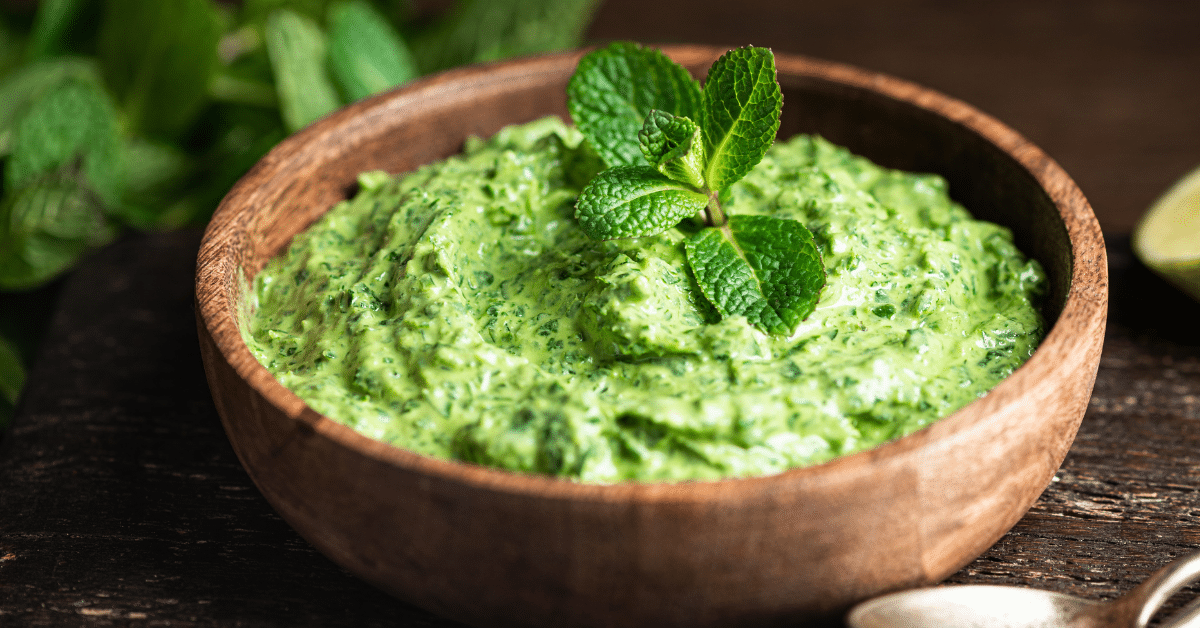
This Ayurvedic mint, pistachio and cilantro chutney recipe makes a tasty side or topping rich in herbs and spices that support digestion, detoxification and overall health.
Ayurvedic Mint, Pistachio and Cilantro Chutney Recipe
Ingredients:
- 1 cup fresh cilantro leaves (finely chopped)
- 1/2 cup fresh mint leaves (finely chopped)
- 1/4 cup unsalted pistachios (soaked for 1-2 hours)
- 1 small green chili (optional, adjust to your heat preference)
- 1 tablespoon fresh ginger (grated)
- 1/2 teaspoon cumin seeds (lightly roasted)
- 1/2 teaspoon fennel seeds (optional, for cooling effect)
- 1 tablespoon lemon or lime juice (freshly squeezed)
- 1/2 teaspoon rock salt (or to taste)
- 1/4 teaspoon black salt (optional for a tangy flavor)
- 1 tablespoon coconut or olive oil (optional for added smoothness)
- 2-3 tablespoons water (adjust consistency as needed)
Optional Additions to this Ayurvedic Mint, Pistachio and Cilantro Chutney Recipe:
- 1/4 teaspoon *turmeric powder: Adds anti-inflammatory properties.
- 1/2 teaspoon jaggery or raw honey: For balancing Vata and Pitta doshas, adds a touch of sweetness.
*Use code KATIES15 for a special 15% discount on all Banyan Botanical products.
Instructions:
- Soak the Pistachios: Soak the pistachios in warm water for about 1-2 hours. This makes them easier to blend and helps release their oils.
- Toast the Spices (Optional): In a small pan, lightly toast cumin and fennel seeds until fragrant. Allow them to cool slightly.
- Blend Ingredients: In a blender or food processor, add soaked pistachios, cilantro, mint, green chili (if using), ginger, roasted cumin, fennel seeds, rock salt, black salt, lemon or lime juice, and turmeric (if using). Blend until smooth. Add water gradually to reach your desired consistency.
- Adjust Seasoning: Taste and adjust salt, lemon juice, or jaggery/honey as needed.
- Optional Oil: Add coconut or olive oil for a richer texture. Blend again for a few seconds to incorporate.
- Serve: Serve fresh with meals or as a dip. Store in an airtight container in the fridge for up to 3 days.
Ayurvedic Considerations for this Ayurvedic Mint, Pistachio and Cilantro Chutney Recipe:
- Vata Dosha: Reduce green chili and use a small amount of oil and jaggery/honey to ground Vata.
- Pitta Dosha: Skip or reduce the chili and black salt, use more mint for cooling, and add fennel seeds to soothe Pitta.
- Kapha Dosha: Skip the oil, use lime juice instead of lemon, and add more chili and ginger for heat and stimulation.
This chutney could be a great addition to an Ayurvedic spring cleanse or our Instant Pot Kitchari.
Enjoy making this flavorful mint, pistachio and cilantro chutney recipe and pairing it with your meals! 🌱